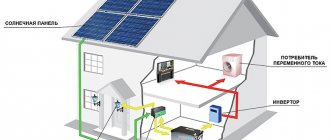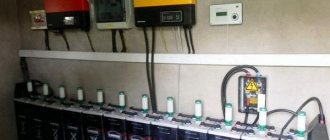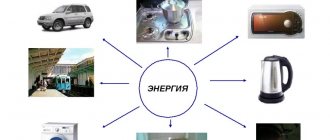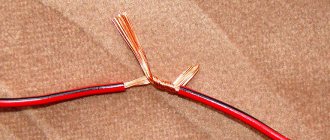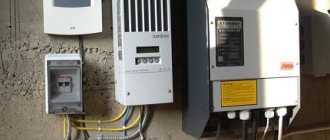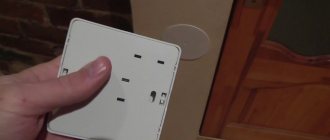First you need to determine the desired power of the future solar power plant
Knowing some criteria will help you with this question:
1) Maximum permitted power
By law, the owner of a private household can build a solar power plant on the roof of his house and/or on the land adjacent to his house, which will generate electricity with a capacity of up to 30 kW/hour.
2) Budget
To determine the required budget, you need to take into account all cost items: all necessary equipment for your solar power plant, other consumables, their delivery to the site, installation work, commissioning work, legal assistance in obtaining a “feed-in tariff” (usually all these items are included in estimate from the installer company) + it is necessary to take into account the costs of increasing the permitted power at your facility (this service is provided by local energy supply organizations). We will consider the issue of increasing power in more detail below.
3) Allowed area
For example, a solar power plant of 30 kW. takes up 145 square meters, which you need to allocate for its construction on the roof of your house or on your garden plot. Below in the article I provide approximate calculations of the required area.
Thus, home owners install solar power plants starting from 5 kW. per hour (this power is usually enough to cover the consumed electricity) and up to 30 kW. per hour (maximum permitted power of solar power plants for private households) depending on the allowed budget and area.
Free master class “COACH IS THE PROFESSION OF THE FUTURE.”
When registering, a bonus checklist of 7 Steps of self-coaching!
Claim bonus
Solar power plants: how to get into a niche and build a business from scratch
Where to mount?
Roof. Mounting solar panels on the roof is an obvious, but not always the best solution for a private home. A south-facing roof slope does provide the best results from permanent solar panel mounting methods, but the options don't stop there.
With this fastening, the roof slope should be to the SOUTH
Walls. If the wall “looks” south, it is perfect for placing solar panels on it. Observe whether shadows from trees, outbuildings, fences, or other objects fall on the wall. Do not place solar panels in these areas.
It is also advisable to use the south wall
You should not place panels on the east or west walls. Thus, during the most intense period of daylight, you will only receive oblique rays on your panels, which significantly reduces the efficiency of the system
Free placement. The most effective option for placing solar panels, but requires free space in the yard. When solar panels are freely placed in a private house, they can be mounted on hinges and thus directing their surface to the sun at 90°.
This arrangement of batteries allows you to get maximum power from them
3. Make sure all necessary documents are in order!
In order to avoid any difficulties at the stage of applying for a feed-in tariff, this point needs to be clarified as early as possible! According to the Law, an individual installs a solar power plant to provide electricity to his private household, and sells the excess electricity generated to the network at a feed-in tariff.
The concept of “Private Household” means a residential building, which means that the owner has the necessary documents that confirm that the house has been put into operation and belongs to him either by right of ownership or under a lease agreement. I would like to immediately note that even if the solar power plant is located on a plot of land, the presence of a house put into operation on it and all the relevant documents is mandatory!
Green tariff: what are the benefits of solar power plants
In addition, if the solar power plant will still be located on a plot of land that is adjacent to the household, then in addition to documents for the house, you also need documents confirming ownership or a lease agreement for the land, or technical documentation for the house, which indicates the boundaries of this plot.
Comments:
Max
According to my calculations, my batteries paid for themselves in 3 years. But I use them in my own greenhouse for the irrigation system and lighting.
Petro
5 years is the average payback period. If the battery is fixed permanently. If you rotate it every day after the sun from dawn to sunset, you can reduce this time, but do you want to turn the battery every 3-4 hours every day?
Nikita
Who can tell me how thick the glass above the radiators should be to prevent hail damage on the roof?
Artem
Nikita, I set it to 5mm - I think it’s enough. We were caught in hail and covered in snow. Everything remained intact.
Michael
Either I didn't understand something, or I didn't understand something. Explain in your fingers what the coefficient 16 is and where it comes from. And in general, why exactly 16, and not 25 or 42?
ScottZom
Thank you for the publication, everything is written very correctly!
umbrella
Hello to the author of the section where a large-scale calculation of the power of a geo-installation is given. INTERESTING, when electricity, the phenomenon of magnetic induction and the categories of quantities associated with these phenomena were taught at school, where was the author? He probably played truant (he fed a hippopotamus at the zoo). Since when has electric and any energy been measured in kW (kiliwatts), this is equivalent to measuring flow speed in buckets. Please correct me, it’s a shame that the value of POWER (kW-kilowatt, hp-horsepower) is confused with the value of ENERGY (kW*h - kilowatt-hour, J - Joule)
Amper Voltovich
Test
Amper Voltovich
Nikita, the panel already has protective glass, special, tempered 3mm. Withstands the impact of a steel ball weighing 260g. from a height of 1 meter. The hail is not afraid of anything.
Amper Voltovich
3.2mm thickness and anti-reflective, moreover.
Amper Voltovich
They talk to themselves, they push and puff up, they can’t take off... Without the Green Tariff, it’s not profitable anywhere. Only losses. Installing panels, if there is a network, can only be done by a complete Ipanko, like the author who just got out of the cow and heard the ringing... This is a complete Pezdos!
Amper Voltovich
Umbrella, Bravo! You forgot to indicate that J=1W*sec. Well, you never know, maybe the author forgot, accepted....
Andrey Vitalievich
The site owner needs to have an idea not only about TOE, but also an idea about RES, especially in the direction of presenting material to the audience about payback and calculating equipment parameters. It's a long journey of workshops, self-study, googling and practice. The advice is to delete everything and start all over again. You can watch (not steal) content from colleagues. But don’t forget about the semantics of the content and relevance to queries. You are mistaken in the payback period of 4-5 years; with batteries, solar generators do not pay for themselves even in 15 years!!! Only if there is a state support for microgeneration and grid inverter. Sincerely, Andrey Vitalievich, director of the company.
C8E3EEF0FC
The author’s incorrect use of units of measurement raises suspicions regarding the fact that he understands what he is writing about...
C8E3EEF0FC
In particular, a physical quantity with the dimension kW/hour does not exist in nature. Power is measured in watts (and their multiples: milli-, kilo-, mega-, etc. watts), hp. ... Energy - in Joules, kW*hours, calories, etc. That is, simply put, power = energy/time, respectively: energy = power * time. What is power/time?
C8E3EEF0FC
Sorry about that: “mil-” it meant “mile-”. It’s bad that there is no way to edit a comment that has already been sent.
Zygmund
It is correctly noted that the main criterion is ecology. And there can be no talk of payback.
Alex
https://trinixy.ru/136213-vsya-pravda-ob-effektivnosti-solnechnyh-paneley-10-foto.htm Here is an interesting link to how a person used the system for more than a year.
Alex
payback period is 25 years. calculation at the highest electricity consumption the cost of kW is 3.04 rubles up to 150 kWh / month. 3.81 rubles from 150 to 800 kW h/month. You will never get back these batteries at these prices. In Europe they are installed because of high tariffs, but in our country they are still low. There is no point in buying them...
Dmitriy
You just don’t want to pay your “uncle” - let him walk around gritting his teeth, saying that you have light and warmth, I don’t pay him!
Leave a comment Cancel reply
Related Posts
Is it profitable to buy a set of solar panels for a summer residence?
Pros and cons of vertical wind generators, their types and features
The principle of operation of solar panels.
Windmill for a private home - a toy or a real alternative
Equipment selection
The main components of a solar power plant are the inverter and the solar panels themselves. As when choosing any other equipment, the determining factor is the ratio of price and quality. And if everything is clear with the price, then to determine better inverters they look at the reputation of the manufacturer, the number of models produced, service, warranty and monitoring capabilities. Also, when considering the technical characteristics of the inverter, you need to ensure that its rated power does not exceed 30 kW, that is, the maximum permissible.
To select a particular brand of solar panels, use the “Tier” rating, which will determine the level of the manufacturer. According to its classification, all manufacturers are divided into three levels, Tier 1, Tier 2 and Tier 3. The rating allows us to assess the extent to which a particular company approaches production responsibly. Thanks to the Tier indicator, you can evaluate how well the declared technical characteristics of the solar battery correspond to the actual ones.
- For example, manufacturers of Tier 1 solar panels guarantee that during the year, generation losses will not exceed 0.8%, that is, after 10 years of operation, the panel’s power should not decrease by more than 8-10%.
- Manufacturers of Tier 3 equipment do not guarantee a uniform reduction in generation power; in practice, this can lead to the fact that after two to three years of operation, the power can sharply decrease by 10%.
The same goes for other parameters of the solar panel. A high rating shows how well a manufacturer can provide warranties and technical support to its distributors, which is also important for assessing quality when purchasing solar panels.
Where to begin
Calculation of electricity costs. To determine the required power of a solar panel system, you need to calculate how much electricity you use. Much in this matter depends on whether a private house is used constantly or only as a summer house in certain seasons of the year. To calculate, take electricity payment receipts for the year and determine the total number of kilowatts spent during this period, then divide by 12 (the number of months) - you will get the average monthly electricity consumption.
Calculation of average monthly electricity consumption
As experience and reviews from real consumers show, in central Russia the result must be multiplied by a factor of 16 to obtain the required battery power in Watts.
Let's look at an example. In a year you spent 1625 kW, divide this figure by 12 months and multiply by a factor of 16 - it turns out 2166 watts. Those. a solar panel system will provide such a house if its power is at least 2200 Watt/hour
Increasing input power
Typically in private households the voltage is 220 v, 1 phase and 5 kW of input power. And to launch a network solar power plant with a capacity of over 5 kW, you need to connect three phases and increase the permitted power in proportion to the power of the inverter of your solar power plant. That is, before connecting a solar power plant, the permitted input power per household must correspond to the rated power of the inverter.
To do this, you must submit a corresponding application to your local energy supply company and pay bills for the increased number of kilowatts. This step should be completed before the construction of a solar power plant begins, as it can take from two to three weeks to several months.
Layout features
In order for the solar power plant you create to work as efficiently as possible, it must be designed according to a certain scheme. Briefly, this diagram can be depicted as follows. Direct current from the photocells is supplied to the charge controller. As a rule, it passes through a special junction box. After the controller, the current flows to the battery, and part of it is used to store energy. Behind the battery is an inverter that converts this direct current into alternating current. Next, the energy flow is distributed to household loads. Moreover, it is best to use a different inverter for each group of loads.
Commissioning
After the power has been increased and the solar power plant has been installed, you need to apply to the electricity supply company to install a metering station. The application must be accompanied by a set of title documents for the house, a copy of the owner’s passport and code, a single-line diagram of the installed solar power plant, as well as certificates and technical specifications of the equipment.
The commissioning of the power plant takes place in accordance with “Section II of the Resolution of NKREKP No. 229 dated 02.25.2016 Procedure for the sale, accounting and payments for electrical energy produced from solar radiation energy by electric power facilities (generating installations) of private households.”
After the household consumer has paid for the services for installing a metering station, the electricity supply company, within three days in cities and five days in rural areas, installs the metering station and issues the consumer a distribution point passport. From this moment, the inverter starts and the station begins to operate and supply electricity to the network.
Top 10 myths about solar power plants
Selecting the type of photoconverter
Activities to create a solar generator with your own hands begin with choosing the type of photovoltaic silicon converter.
These components come in three types:
- amorphous;
- monocrystalline;
- polycrystalline.
Each option has its own advantages and disadvantages, and the choice in favor of any of them is made based on the amount of funds allocated for the purchase of all system components.
Features of amorphous varieties
Amorphous modules do not consist of crystalline silicon, but of its derivatives (silane or hydrogen silicon). By spraying in a vacuum, they are applied in a thin layer to high-quality metal foil, glass or plastic.
The finished products have a faded, blurry gray tint. No visible silicon crystals are observed on the surface. The main advantage of flexible solar panels is their affordable price; however, their efficiency is very low and ranges from 6-10%.
Amorphous solar cells made from silicon have increased flexibility, exhibit high levels of optical absorption (20 times greater than mono- or polycrystalline counterparts) and operate significantly more efficiently in cloudy weather
Specifics of polycrystalline types
Polycrystalline solar cells are produced by gradually cooling a silicon melt very slowly. The resulting products are distinguished by a rich blue color, have a surface with a clearly defined pattern reminiscent of a frosty pattern, and exhibit an efficiency of around 14-18%.
Higher efficiency performance is hampered by the areas present inside the material, separated from the overall structure by granular boundaries.
Polycrystalline solar cells operate for only 10 years, but during this time their efficiency does not decrease. However, to install products into a single complex, a strong, solid base must be used, since the sheets are quite rigid and require strong, reliable support
Characteristics of monocratylic variants
Monocrystalline modules are characterized by a dense dark color and consist of solid silicon crystals. Their efficiency exceeds that of other elements and amounts to 18-22% (under favorable conditions - up to 25%).
Another advantage is the impressive service life - according to the manufacturers, over 25 years. However, with prolonged use, the efficiency of single crystals decreases and after 10-12 years the photoreturn is no more than 13-17%.
Monocrystalline modules are significantly more expensive than other types of equipment. They are produced by sawing artificially grown silicon crystals
Due to the fact that photocells are valued quite highly, many suppliers offer customers products of group B, that is, fragments suitable for full use with a slight defect. Their cost differs from the standard price by 40-60%, so assembling a generator costs a reasonable price that is not too expensive.
How to make a solar battery with your own hands?
Many companies on the Internet sell ready-made panels that are directly connected to the consumer. But such devices have a much higher cost than individual elements. Due to the peculiarities of the climate zone, you are unlikely to be able to completely switch to solar electricity, so ready-made solar panels will only be able to pay for themselves in 10 to 40 years. To save on expensive factory panels, it is much more profitable to purchase photovoltaic modules, components for them and assemble the cells into a single solar battery yourself.
Where are solar generators used?
Solar generators come in different models and have different characteristics (namely performance, battery capacity, time required for charging, etc.). But most often they all have output parameters - 220 V sockets and 12 V outputs, and also have a display showing the operation of the device.
Despite their versatility, solar powered generators are dependent on weather conditions. Therefore, they can only be used as a backup or auxiliary source of electricity. This is of particular relevance for residential buildings, especially in remote corners of the country and areas with unstable power supply.
Solar panels are installed outdoors in places with the greatest access to sunlight, because their efficiency is directly dependent on illumination. Most often they are placed on the roofs of houses or in other suitable areas. In this case, it is desirable to provide the ability to change the angle of inclination of the photocells. For example, increasing it to 75-80 degrees, we get that the rays of the sun at 12-00 in the afternoon are almost perpendicular to the surface of the battery. Solar panels are very easy to install and connect, and they are easy to maintain. They are connected to the generator using a special power cord.
The solar generator is designed for use as the main and additional (backup, emergency) power source of private houses and cottages, dachas, retail facilities, demonstration sites, tourist centers, etc. It has a very wide range of uses. Can be used to provide electricity to lighting and household appliances (refrigerators, televisions, laptops, computers, office equipment), power tools, drainage and circulation pumps, heating boilers and so on. The battery life of all models is different, but almost all of them are quite productive and can work continuously for up to 10-12 hours.
Preparation of tools and selection of materials
In addition to converters, to assemble a full-fledged solar panel you will need the following materials:
- Solder – Solar cells require low-melting tin alloys.
- Connecting wires - single-wire copper grades are selected. Bare conductors are used to connect monocrystalline and polycrystalline wafers, and insulated conductors are used to remove electricity.
- Frame – creates the main frame in which the entire solar panel is located. It consists of a base - chipboard, USB, plywood and others, metal or wooden strips, corners and screws for connecting them.
- Glass or polymer plate - creates a protective layer on top of monocrystalline plates, also, in combination with a frame, serves to hide elements from the effects of precipitation and mechanical influences.
- Sealant - the best material for sealing is epoxy compound, but this is quite expensive, so it can be replaced with silicone sealant.
- Rechargeable battery – designed to accumulate electrical energy during daylight hours for further use. There is no point in saving when choosing a battery, as a high-quality model will last much longer.
- Inverter - used to convert direct voltage into alternating voltage. A voltage converter is necessary to connect any household appliances to the solar battery.
The tools you will need are a hacksaw, a drill, a screwdriver or a regular screwdriver for tightening screws, a multimeter or ammeter to determine the performance of a solar battery, and a soldering iron.
